Canning Cherry Tomatoes (Two Simple Ways!)
This post may contain affiliate links, view our disclosure policy for details.
Canning cherry tomatoes during the growing season is a great way to preserve them for long-term storage. We can do this in two ways; raw pack and hot pack. In this post, I’ll show you how to can cherry tomatoes both ways.
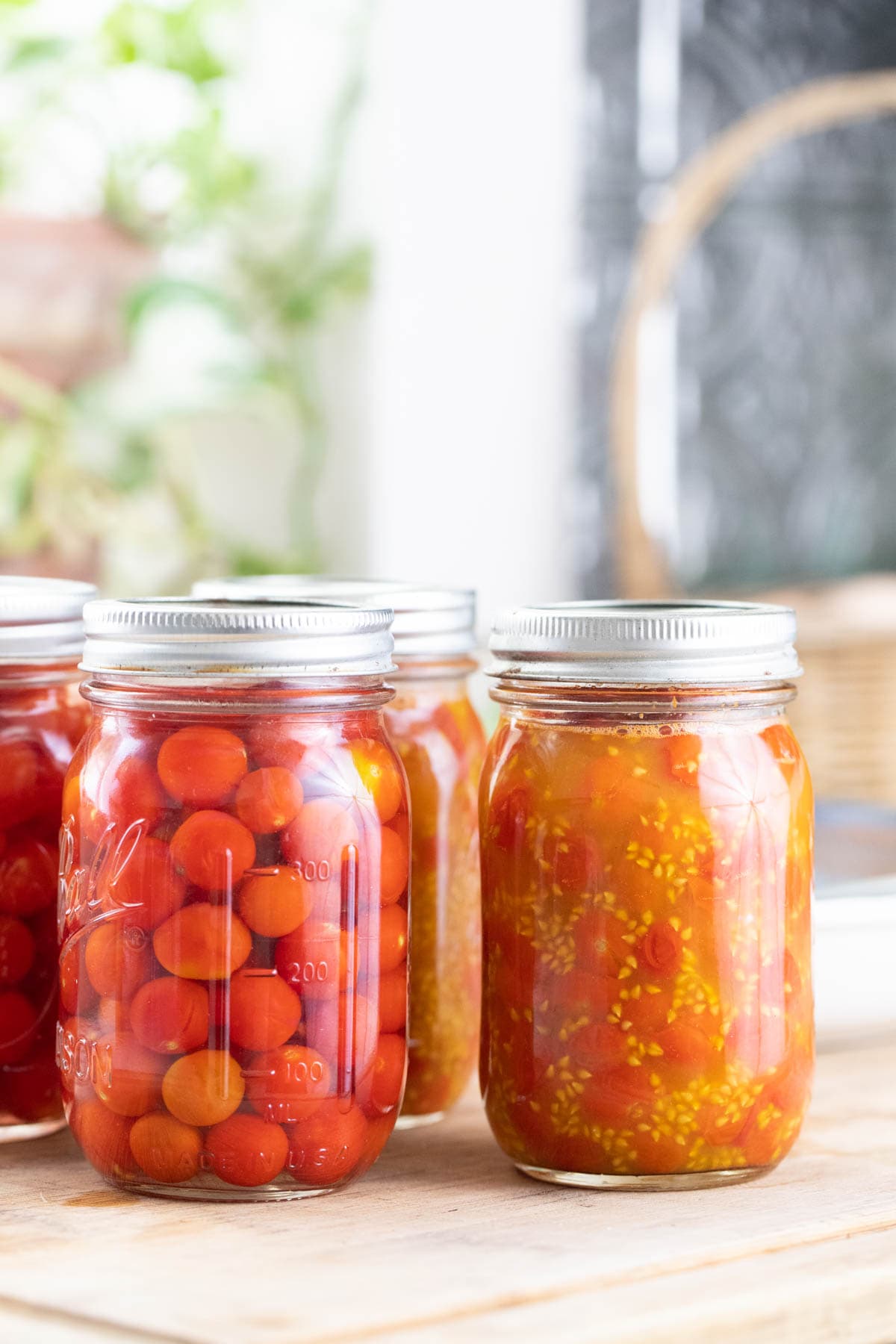
Lady Lee’s Notes…
One cherry tomato plant can produce so many tomatoes that, for the longest time, when I was only growing for our family, I had a few cherry tomato plants in the garden. We mostly ate them fresh; however, sometimes I had so many that I canned them.
Raw Pack Vs. Hot Pack…
- Raw Pack – we can simply pack jars with raw cherry tomatoes, add some acid and boiling water, and process the tomatoes in the water bath canner.
Packing the jars with raw tomatoes is easy and takes just a few minutes; however, when you process the jars in the heat of the boiling water, the tomatoes will burst open and release some of their juice and shrink a bit. Sometimes, you’ll end up with a jar that looks half full after it cools. - Hot Pack – or, we can cook our tomatoes for a short time before we pack the jars, add acid, and process. It takes a tiny bit longer (and a bit more work), however, we can fit more tomatoes in each jar.
How Many Tomatoes in Each Jar?
To give you an idea, I was able to pack a cup and a half of Matt’s Wild tomatoes (marble size) in each pint-size jar using the raw pack method, vs. two and a half cups of tomatoes in each jar using the hot pack method.
My preferred method is the hot pack, however, I’ll show you both ways, and you can decide which one you’d like to try. Or, for the first few times, try both ways and examine the end result. Then, you’ll have a better idea of which way works better for you.
Ingredient Notes…
- Cherry tomatoes – any variety or color.
- Bottled lemon juice or citric acid – we have to acidify the water when canning tomatoes in the water bath canner in order to help them preserve better, longer. Fresh lemon juice is not consistent in its acidity, so only use bottled lemon juice, or you can use citric acid instead. Either option does not affect the flavor of the tomatoes.
- Sea, canning, or Kosher Salt – this is optional. Some say that it adds flavor. I personally don’t feel a difference.
- Non- chlorinated boiling water – whenever canning, make sure to use non-chlorinated water. If you live in the city, use bottled water you buy from the store instead of tap water.
How to Can Cherry Tomatoes…
Raw Pack…
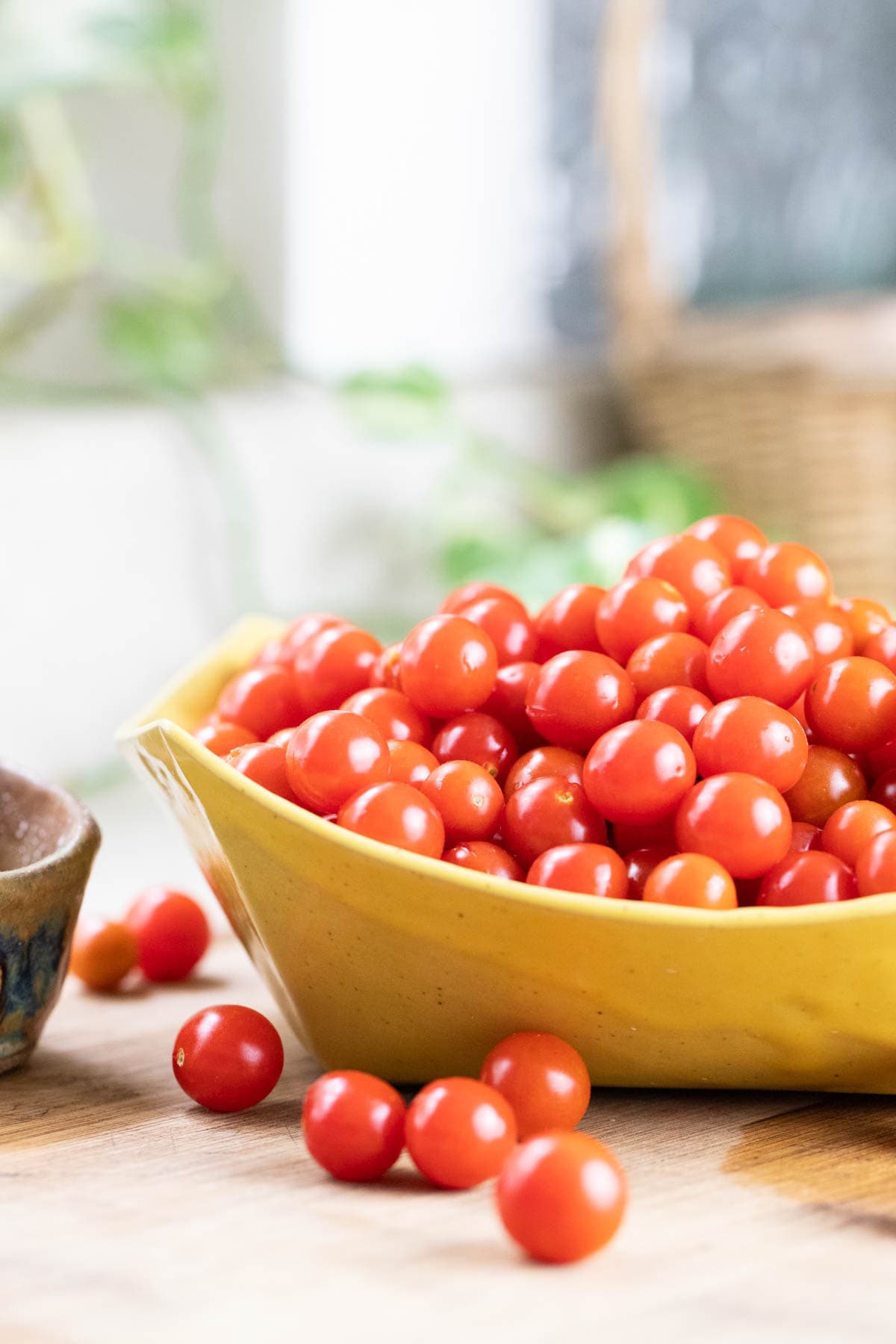
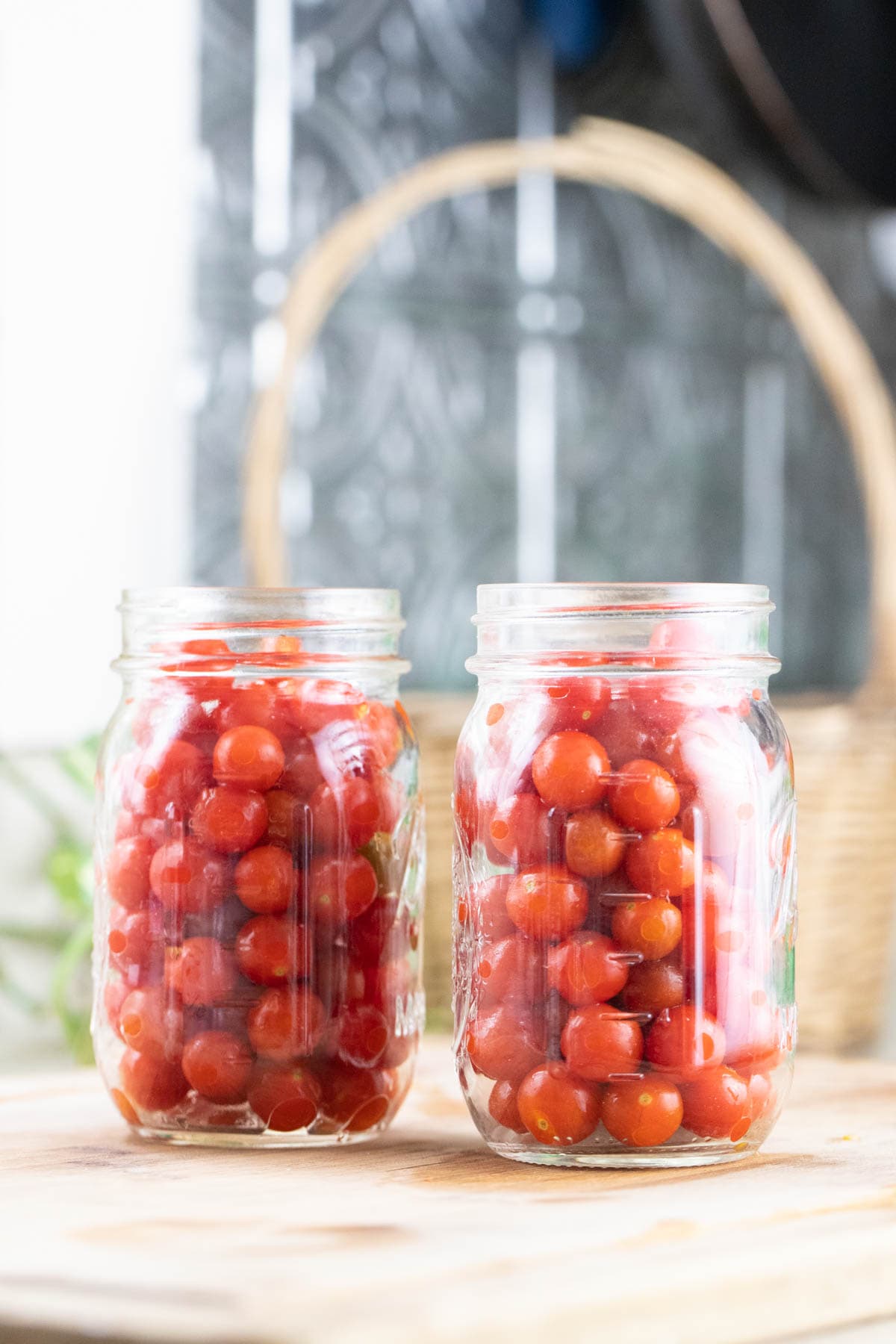
Step one – prep the canner and pack the tomatoes. Before you start prepping your tomatoes for canning, go ahead and fill your water bath canner with enough water to cover the jars by about an inch. Set it on the stovetop, cover the canner and bring the water to a boil. Also, wash your jars, lids, and bands in hot water and soap. There is no need to sanitize them, they just need to be clean.
Wash the tomatoes well in cold water and add them to the jars. Pack them tight but make sure to leave 1/2 inch of headspace.
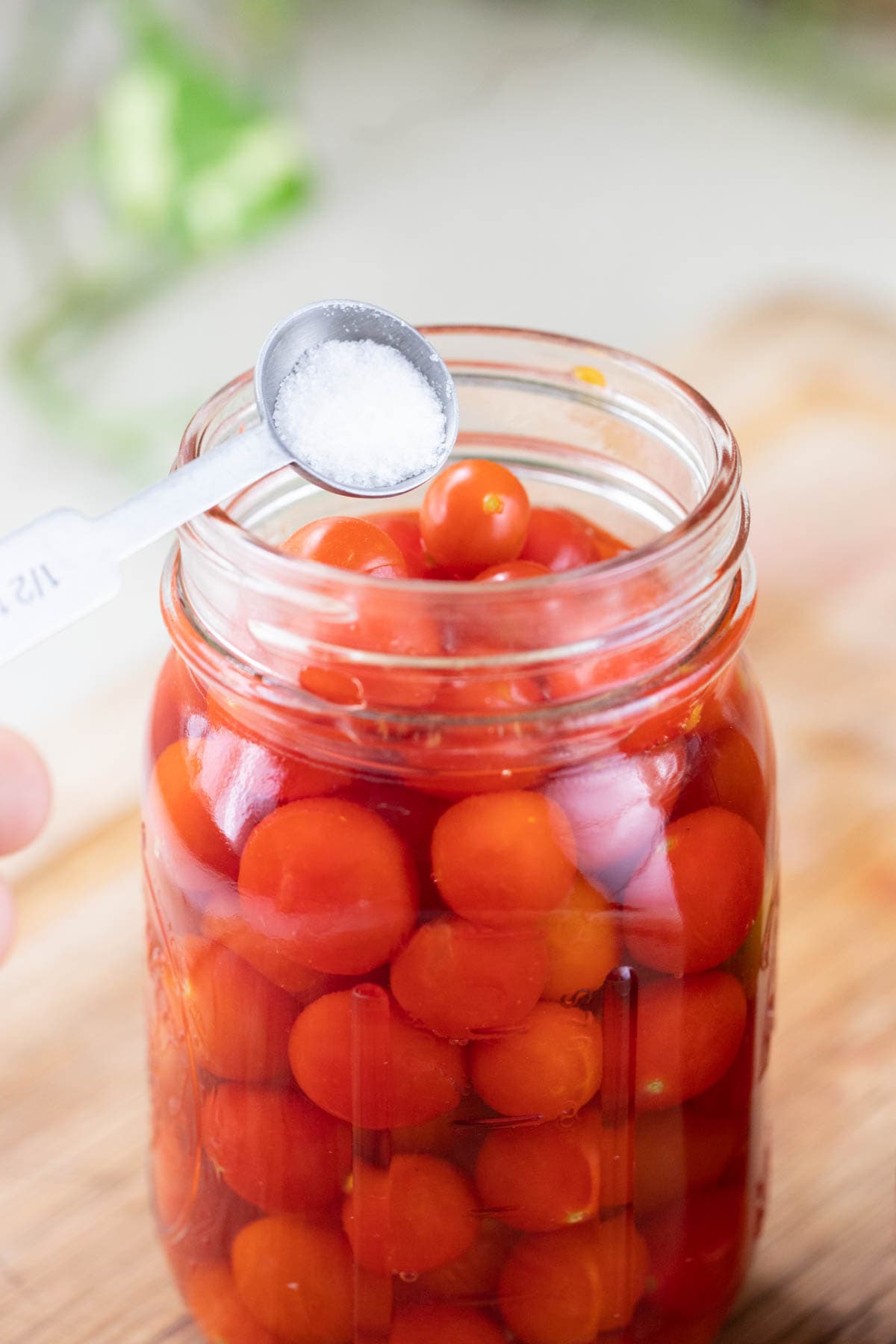
Step two – add acid and boiling water. To each pint jar, add 1/4 teaspoon of citric acid, or 1 tablespoon of bottled lemon juice. To each quart jar, add 1/2 teaspoon of citric acid or 2 tablespoons of bottled lemon juice. If you choose to add salt, add 1/2 teaspoon of salt to each pint jar or 1 teaspoon of salt to each quart jar, then fill the jars with boiling water, leaving 1/2 inch of headspace.
Tip: wait until the water in the water bath canner is boiling and you are ready to process your raw pack tomatoes before you add the boiling water to each jar. This way the temperature of the jars and the water in the canner is similar.
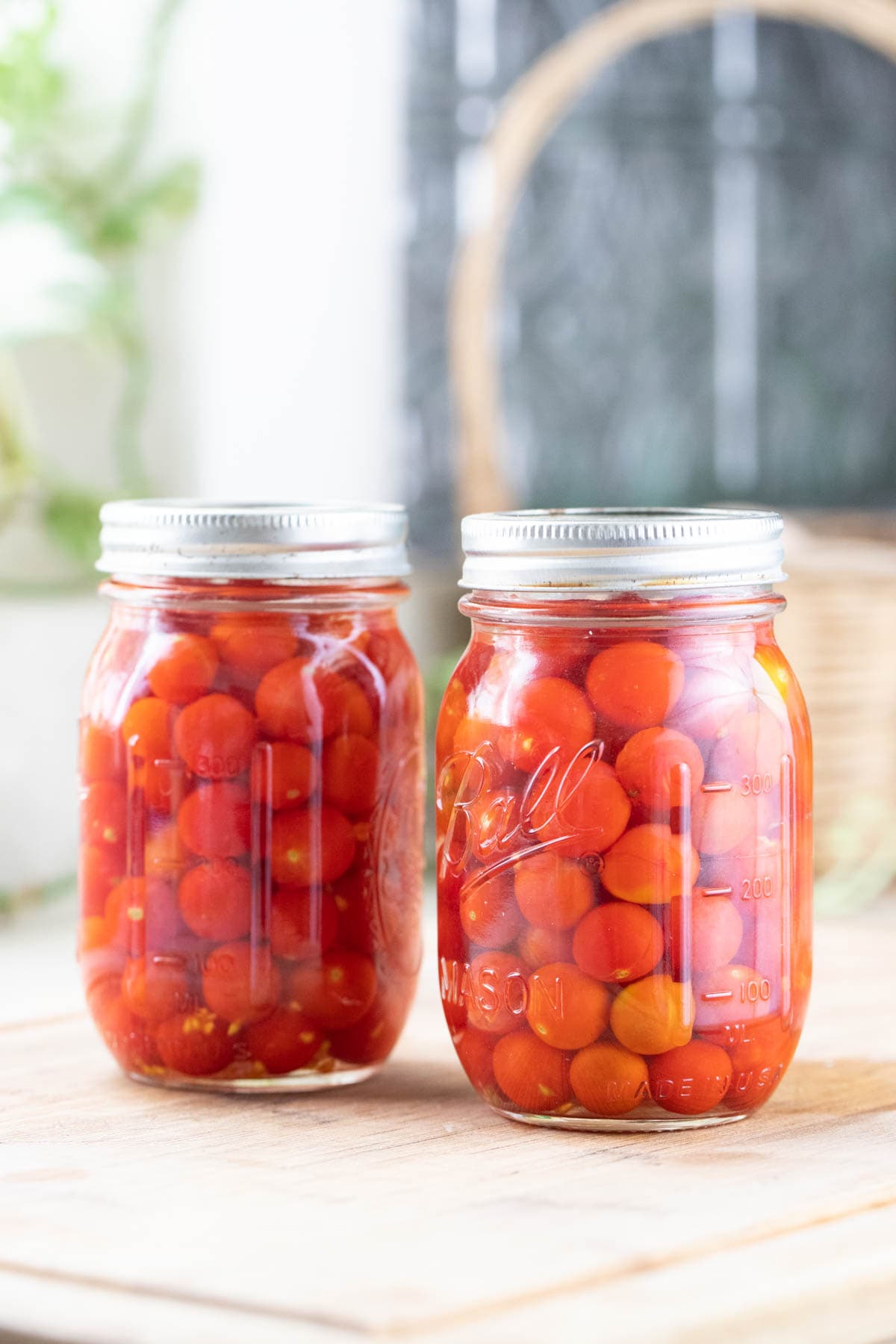
Step three – close the jars. Use the bubble remover to scrape the inside of the jar and remove air bubbles. Then use a damp paper towel to clean the rim of the jar. Center the lid and close the jar with the band finger tight. Your raw pack cherry tomatoes are ready for processing in the water bath canner.
Hot Pack…

Step one – add tomatoes to a pan. Wash the tomatoes well and add them to a pan with a little bit of water. For five cups of small cherry tomatoes, I added one cup of water.
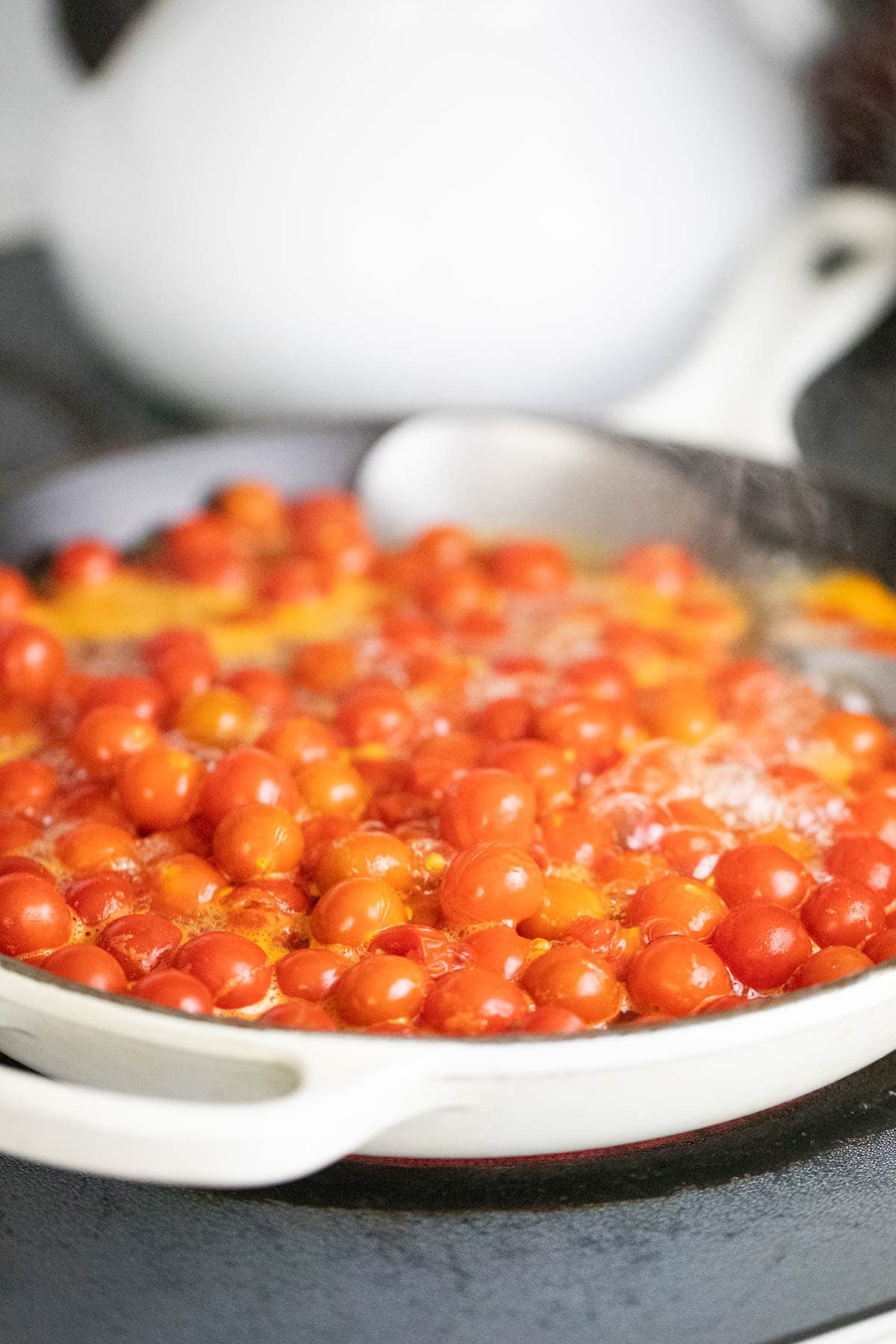
Step two – cook the tomatoes. Set the pan on the stovetop and turn the heat to medium-high. Bring the tomatoes to a boil and let boil for five minutes before turning the heat off.
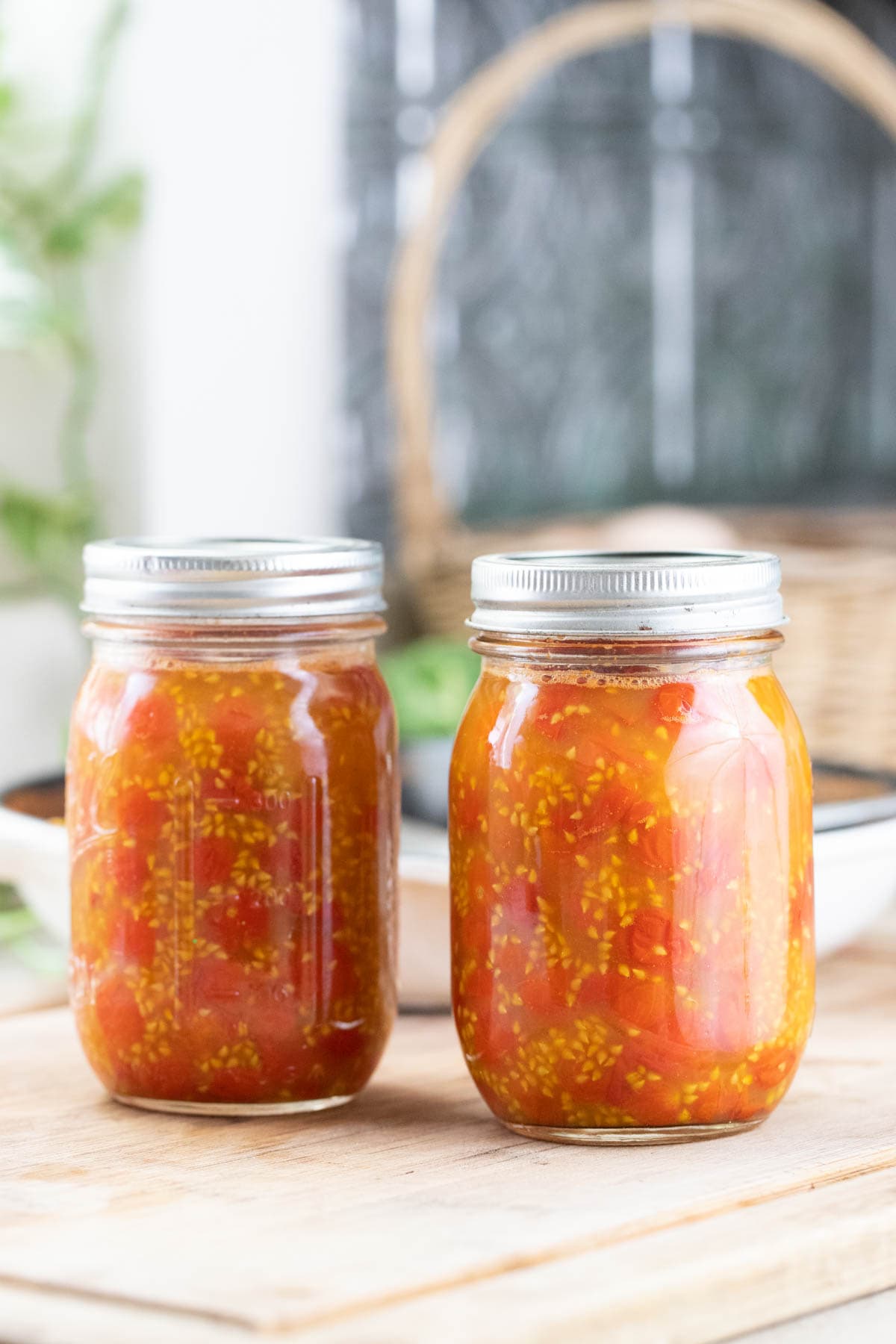
Step three – pack the jars. Use the canning funnel and your large spoon to scoop the hot tomatoes and their juice into the jars. Make sure to leave 1/2 inch of headspace. To each pint jar, add 1/4 teaspoon of citric acid, or 1 tablespoon of bottled lemon juice. To each quart jar, add 1/2 teaspoon of citric acid or 2 tablespoons of bottled lemon juice. If you choose to add salt, add 1/2 teaspoon of salt to each pint jar or 1 teaspoon of salt to each quart jar.
Use the bubble remover to scrape the inside of the jar and remove air bubbles. Then use a damp paper towel to clean the rim of the jar. Center the lid and close the jar with the band finger tight. Your hot pack cherry tomatoes are ready for processing in the water bath canner.
Processing Cherry Tomatoes…
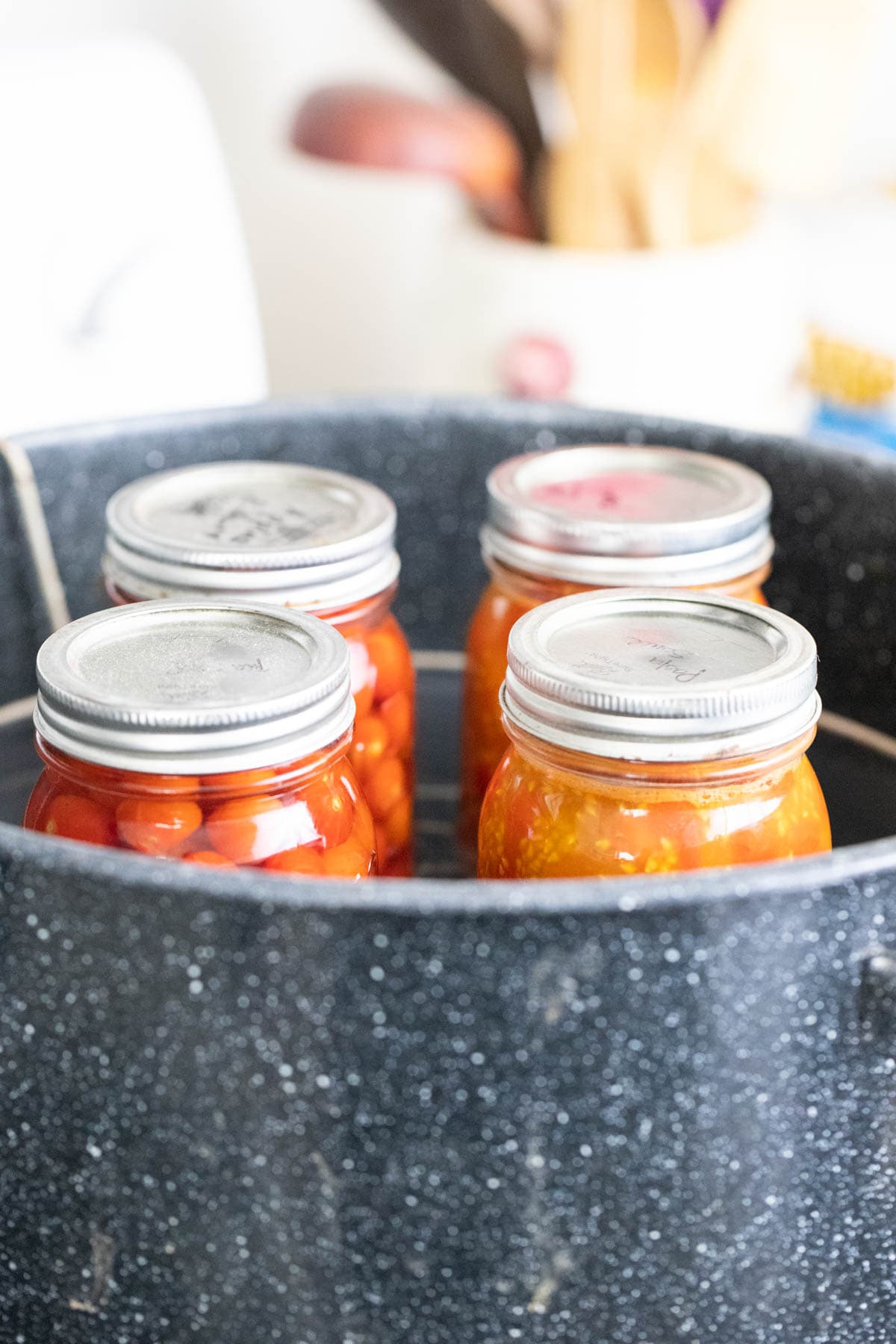
Step four – process the jars. Set the jars of cherry tomatoes on the rack of the water bath canner. Lower the rack to the boiling water, cover the canner, and process quart jars in the boiling water for 40 minutes and pint jars for 35 minutes. Remember to adjust processing time according to the table below if you live above 1000 feet in elevation.
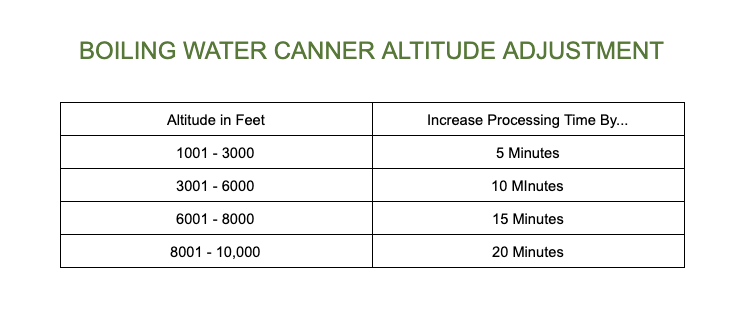
Once processing time is over, turn the heat off and uncover the canner. Let the jars rest in the hot water for five minutes before removing them. Use the jar lifter to remove the jars from the canner and set them on a kitchen towel on the kitchen counter to cool overnight.
How to Store…
Once your jars have cooled completely check that they are all sealed before storing them. Press the center of each lid and if there is no movement there it means that the jar has sealed. If you have a jar that didn’t seal, you can try to process it again or store it in the fridge and use it first. If you choose to process it again, I recommend changing the lid since many times it’s the lid that causes the problem.
Wipe the jars and remove the band since it usually rusts over time and makes it hard to open the jar later. Store your jars of canned cherry tomatoes in a dark and cool place like a pantry for up to 18 months.
How to Use…
- In any dish that calls for tomatoes – I use my cherry tomatoes in any recipe that calls for tomatoes like this Southwest chicken chili or pulled venison.
- In drinks – bloody Mary anyone?
- In tomato soup – is there anything better than a tomato soup from summer garden tomatoes in the dead of winter? I think not.
- To make pasta sauce – creamy tomato pasta sauce is always better with fresh tomatoes. Home canned summer cherry tomatoes are as close as you can get to fresh tomatoes in the winter months and they behave very well in a pasta sauce!
- To make salsa – cherry tomatoes are great for making homemade salsa! Just open the jar and use them in any salsa recipe like this one.
I love growing cherry tomatoes! They are easy to pick, fun to eat fresh right off the trellis, and each plant produces a ton of tomatoes. If you find yourself with a whole lot of cherry tomatoes don’t hesitate to can them!
More Ways to Preserve Tomatoes…
- Canning Tomato Sauce
- How to Freeze Tomatoes
- Canning Stewed Tomatoes
- Canning Crushed Tomatoes
- Fermented Green Tomatoes
- Canning Pickled Green Tomatoes
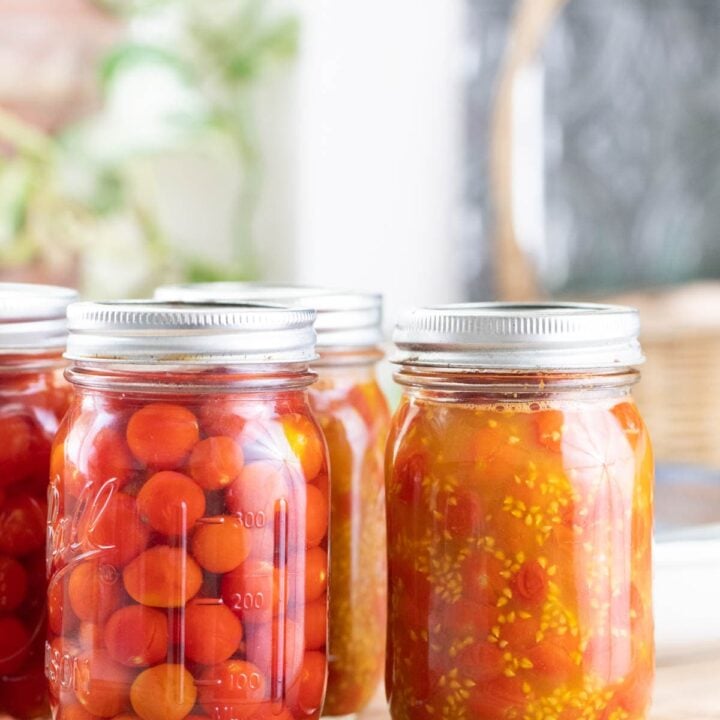
Canning Cherry Tomatoes (Two Simple Ways!)
Canning cherry tomatoes in two ways: raw pack and hot pack.
Ingredients
- Cherry tomatoes (see notes)
- Citric acid or bottled lemon juice
- Non-iodized salt (optional)
Instructions
- Before you start prepping your tomatoes for canning, go ahead and fill your water bath canner with enough water to cover the jars that you are going to use by about an inch. Set it on the stovetop, cover the canner and bring the water to a boil. Also, wash your jars, lids, and bands in hot water and soap. There is no need to sanitize them, they just need to be clean.
- Raw pack - wash your tomatoes well in cold water. Pack the jars tight but make sure to leave about an inch of headspace. To each pint jar, add 1/4 teaspoon of citric acid, or 1 tablespoon of bottled lemon juice. To each quart jar, add 1/2 teaspoon of citric acid or 2 tablespoons of bottled lemon juice. If you choose to add salt, add 1/2 teaspoon of salt to each pint jar or 1 teaspoon of salt to each quart jar.
- Add boiling water to each jar leaving 1/2 inch of headspace. Use the bubble remover to scrape the inside of the jar and remove air bubbles. Then use a damp paper towel to clean the rim of the jar. Center the lid and close the jar with the band finger tight. Your raw pack cherry tomatoes are ready for processing in the water bath canner.
- Hot pack - Wash the tomatoes well and add them to a pan with a little bit of water. For five cups of small cherry tomatoes, I added one cup of water (just to give you an idea). Set the pan on the stovetop and turn the heat to medium-high. Bring the tomatoes to a boil and let boil for five minutes before turning the heat off.
- Use the canning funnel and a large spoon to scoop the hot tomatoes and their juice into the jars. Make sure to leave 1/2 inch of headspace. To each pint jar, add 1/4 teaspoon of citric acid, or 1 tablespoon of bottled lemon juice. To each quart jar, add 1/2 teaspoon of citric acid or 2 tablespoons of bottled lemon juice. If you choose to add salt, add 1/2 teaspoon of salt to each pint jar or 1 teaspoon of salt to each quart jar.
- Use the bubble remover to scrape the inside of the jar and remove air bubbles. Then use a damp paper towel to clean the rim of the jar. Center the lid and close the jar with the band finger tight. Your hot pack cherry tomatoes are ready for processing in the water bath canner.
- Processing - set the jars of cherry tomatoes on the rack of the water bath canner. Lower the rack to the boiling water, cover the canner, and process quart jars in the boiling water for 40 minutes and pint jars for 35 minutes. Remember to adjust processing time according to the table in the notes if you live above 1000 feet in elevation.
- Once processing time is over, turn the heat off and uncover the canner. Let the jars rest in the hot water for five minutes before removing them. Use the jar lifter to remove the jars from the canner and set them on a kitchen towel on the kitchen counter to cool overnight.
- Once your jars have cooled completely check that they are all sealed before storing them. Wipe the jars and remove the band since it usually rusts over time and makes it hard to open the jar later. Store your jars of canned cherry tomatoes in a dark and cool place like a pantry for up to 18 months.
Notes
Kitchen Tools:
- Jars, lids, bands - use either pint size jars or quart size jars to can cherry tomatoes. Make sure that your lids and bands are new or in very good condition.
- Measuring spoons
- Pot or pan - if you choose to hot pack your cherry tomatoes.
- Large spoon - for stirring hot pack tomatoes while they are cooking and for scooping them from the pan to the jars.
- Canning utensils
- Damp paper towel
- Water bath canner
Adjust processing time according to the table below...

Frequently Asked Questions...
- Does it matter what kind of cherry tomatoes I’m canning?
No, you can follow this tutorial to can any kind of cherry tomatoes even black ones, or orange ones, or yellow ones or cherry tomatoes in different shapes. - Is processing time the same for raw pack and hot pack?
Yes, the same processing time for both methods. 40 minutes for quarts and 35 for pints. Remember to adjust if you live higher than 1000 feet in elevation. - My tomatoes are sour, do I still need to add acid before canning? Yes, just a little bit to make sure that they’ll last on the shelf for a long time.
- Can I season my tomatoes?
It’s better not to because when we start adding different ingredients we change the levels of acidity. When you do that, you might need to process your tomatoes in a pressure canner instead of in the water bath canner as I do when canning stewed tomatoes.
Nutrition Information:
Yield: 4 Serving Size: 1 pint jarAmount Per Serving: Calories: 10Total Fat: 0gSaturated Fat: 0gTrans Fat: 0gUnsaturated Fat: 0gCholesterol: 0mgSodium: 146mgCarbohydrates: 0gFiber: 0gSugar: 0gProtein: 0g


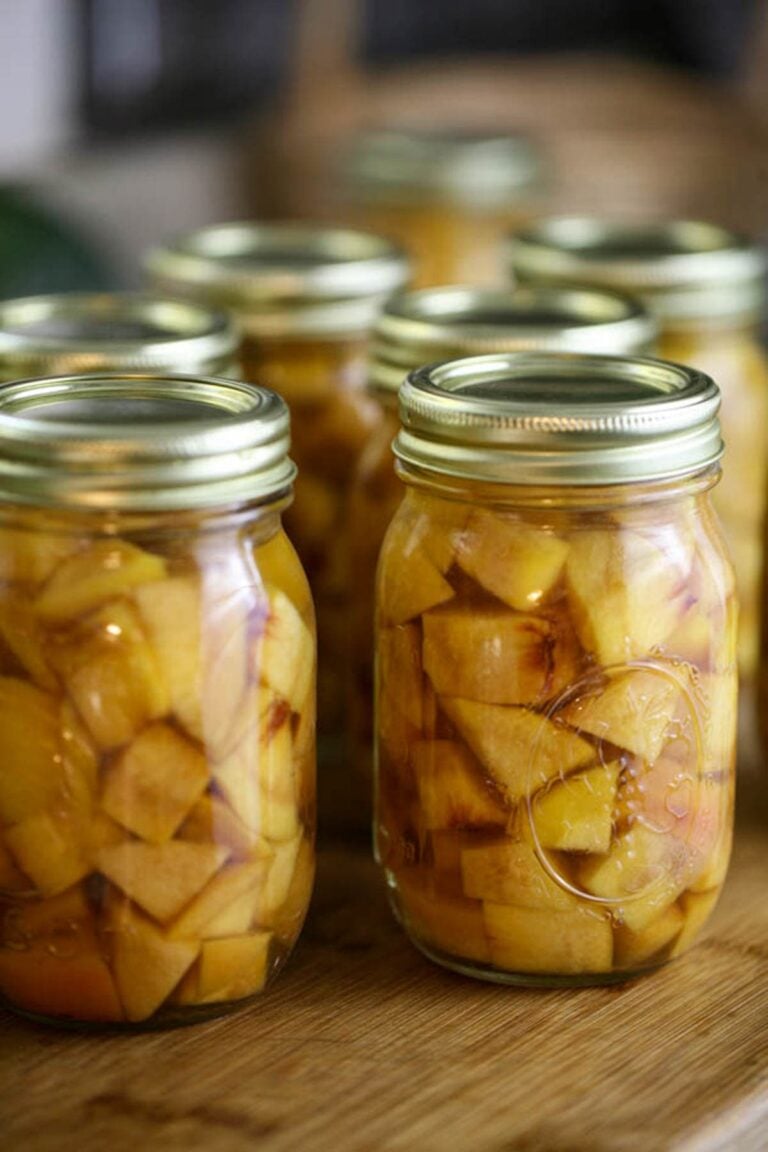
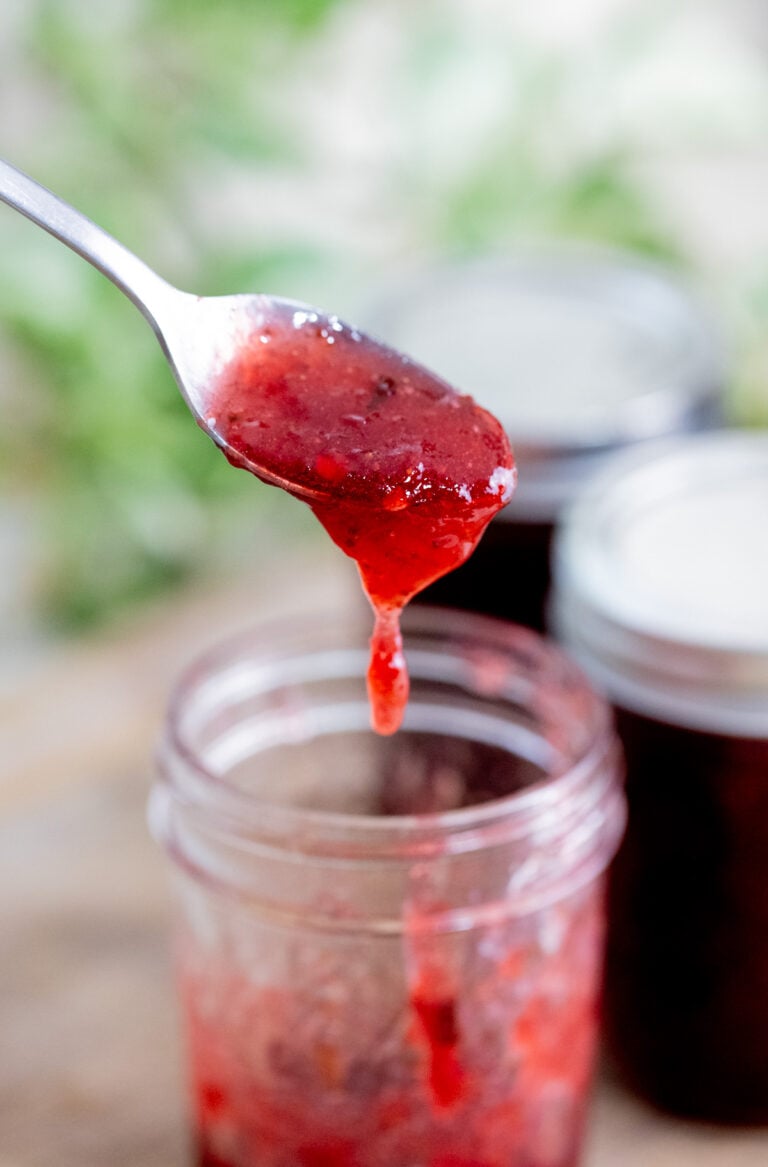
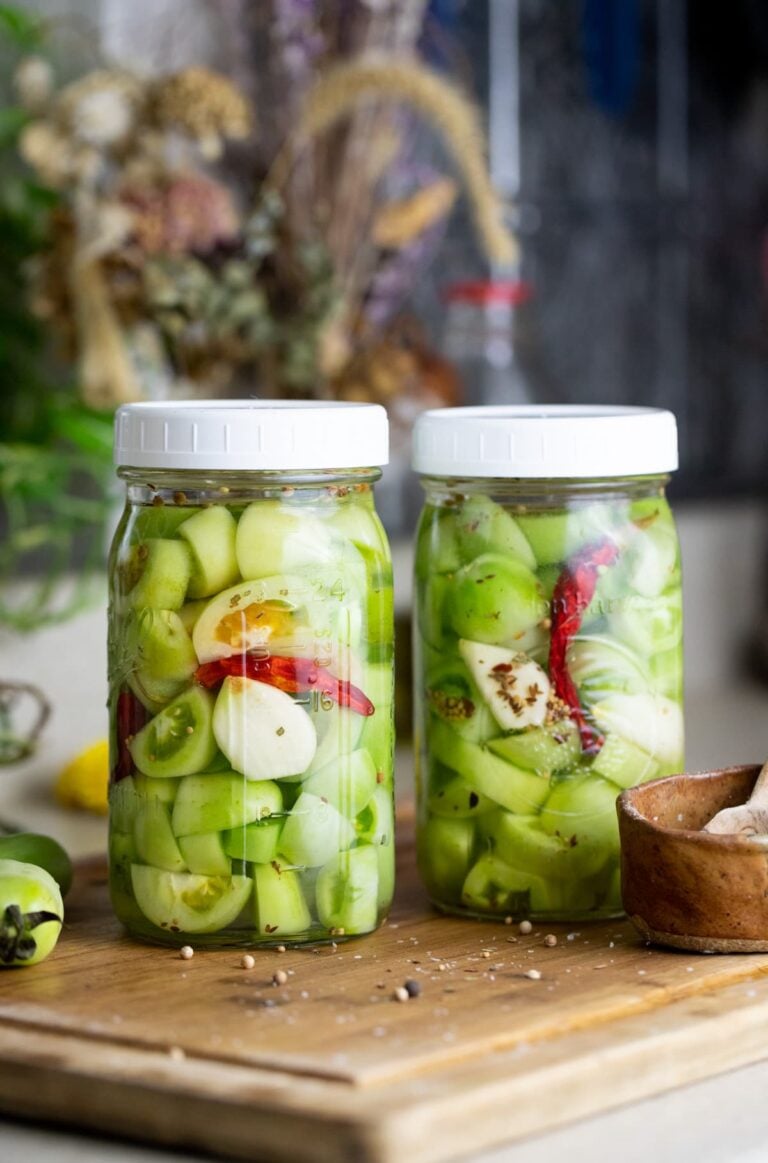
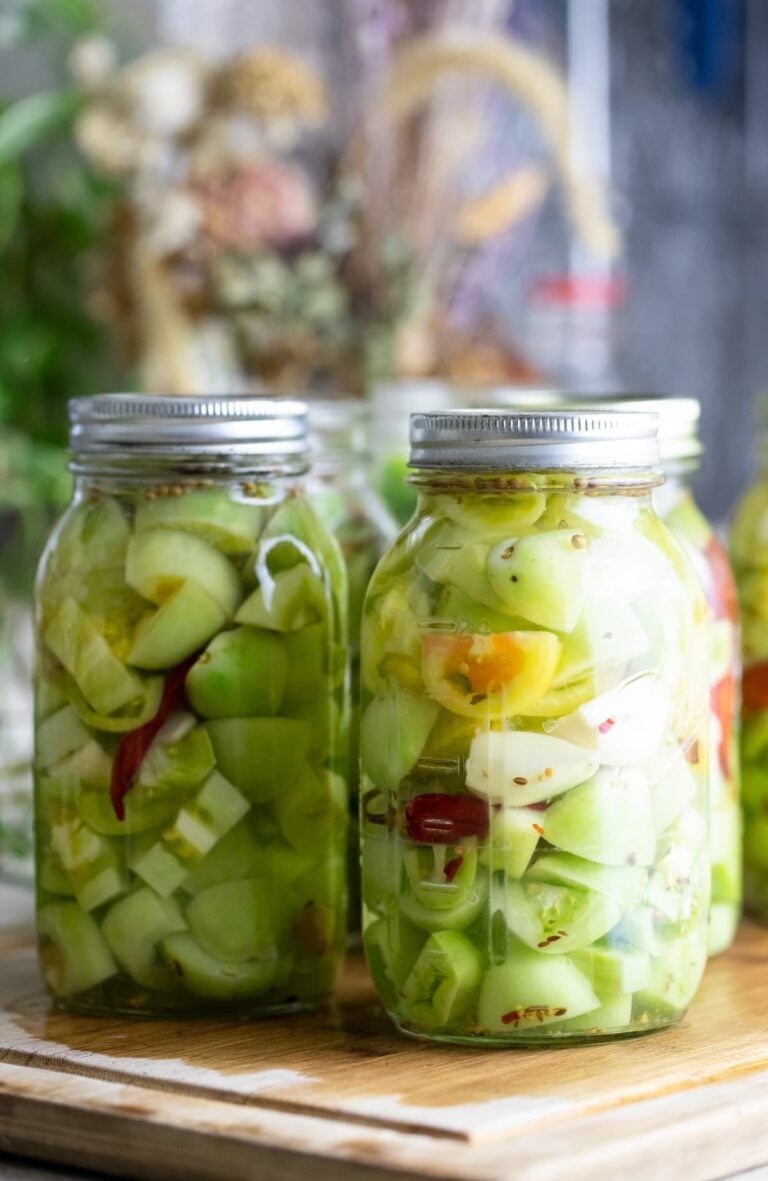
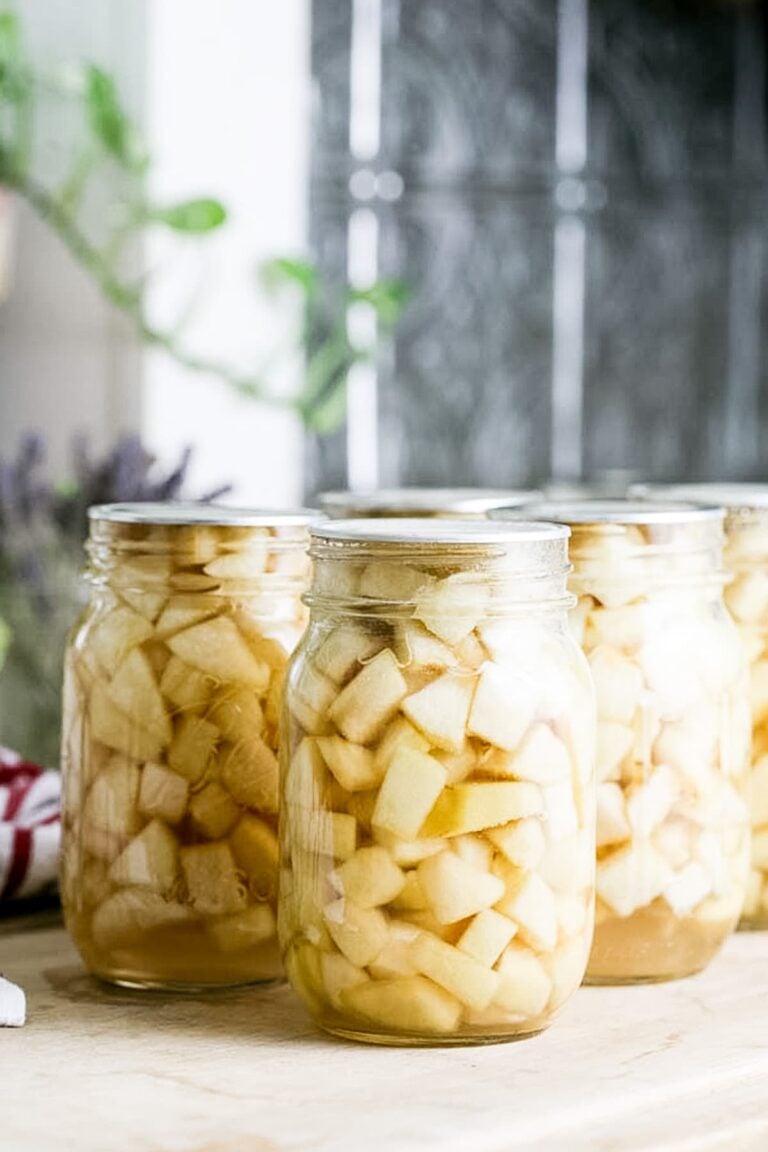
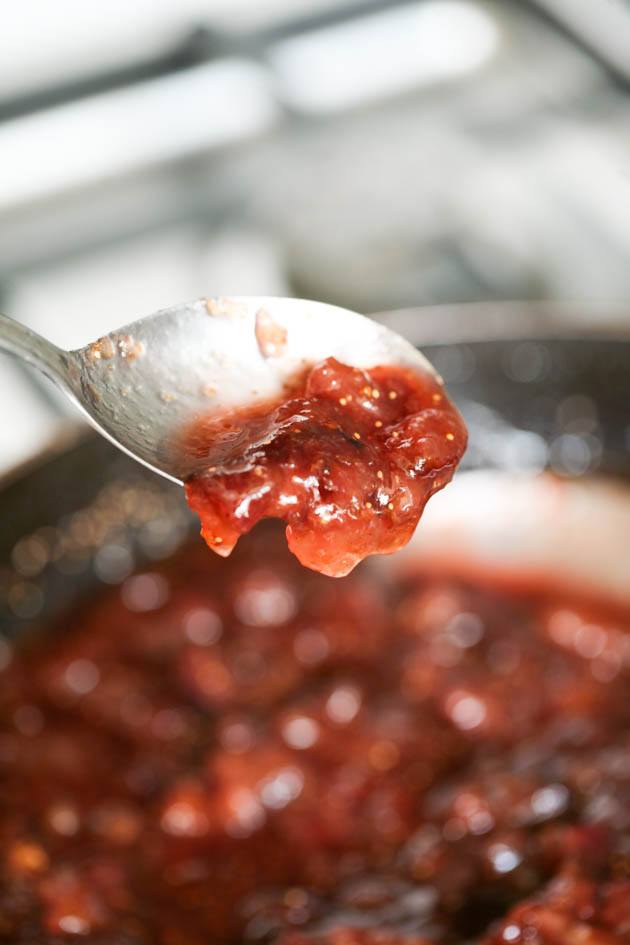
I am going to try the dry pack method. My daughter loves cherry tomatoes.
Thank you,
I hope all will go well! Thanks for stopping by!
Hi Lee,
I was curious as to the shelf life of the cherry tomatoes – cold and hot packs.
I am planning on doing the cold pack, don’t have a canner so water bathing them. Tried this method with carrots and they are 2 years old and still look clear in the brine solution.
I am all for preserving that is mainly for those who don’t have canners – on a limited income so can’t afford it. Going to look through your site further so I can preserve much more. Thanks for the simplicity of the above recipe.
I don’t use Pinterest, facebook, twitter, youtube, instagram, none of these, although I do download from youtube some times.
Mine have been on the shelf for two years and still look good. I think that they can stay in the can for a long time but they’ll start losing their taste the longer they are in the jar.
Hi! These ideas are really appreciated! Thank you! Just wanted to mention that, when using the “Print” option, it’s printing in a gray text so light it’s completely illegible. Strange, I know, but there it is.
Are you talking about the print button that is at the top of the post or the print button that is in the recipe card at the end of the post? I’ll try both but would love to know which one you are talking about. Thanks so much for letting me know!
You have a good/realistic picture of post processing hot packed cherries.
However, you say that if the cherries are raw packed they can split in processing yielding a jar as little as half full. If any of the pictures of raw packed cherries are post processing none show this likely result. It would be very helpful to see what that looks like. Is there a picture you can share?
Thanks!
Ha, I thought I had an “after” image there… I did use all of my canned cherry tomatoes so I can’t take another picture at the moment but I’ll do it as soon as I can. Basically the tomatoes will float so the bottom of the jar (maybe an inch or so) will just be water.
I am new to canning although I’ve been researching canning for a few years, this is the simplest and best recipe I’ve ever seen. Thank you for making it so easy! Do you have a recipe for canning beans please?
Thank you, thank you, thank you! This is my number one purpose… to make it as simple as possible and I am glad you liked it.
I don’t yet have a canning beans recipe but will definitley put it on the list. Thanks for stopping by.
Why non-iodized salt?
It may cause darkening, discoloration of the food, or spotting. When preserving food, in any way, we use kosher, sea, or canning salt.
Same here! I grew 45 large tomato plants and it was hard to get anything to can from them..So, i said to myself >I get a TON more tomatoes from my Juliets, chocolate cherries, sweet millions, sungolds and other small varieties, so i think i am just gonna can them??And for last 5 years i
that is all I have been canning, only small matoes.
I love Juliets and chocolate cherrys, they are good size and produce a vast amount..
Yep. This year I planted a couple of large varieties by mistake. The pictures in the seed catalog showed the tomatoes pretty small but they grew giant and many of them had blossom end rot. I had a few Matt’s Wild and like seven chocolate cherries, they are still producing! I think that next year I’m not gonna try anything new, I’m just going to do those two varieties.
Hello!
I followed the raw packed instructions and there seems to be some sort of white substance floating around in my jars. It doesn’t appear to be mold and I used bottled lemon juice without pulp (my initial thoughts). Any ideas? Safe to eat?
Thanks!
Did the jars seal properly?
I can’t think of anything aside from mold… And just so you know, the white mold is not harmful. So you can remove it and still use the tomatoes.
I can and also learned years ago that no matter how much I tried I only got a few pounds of large tomatoes per plant compared to 20+ lbs of cherry and grape tomatoes per plant..
So I also switched to growing to can only the smaller tomatoes and growing a larger tomato plant to slice and eat… This year I grew Juliet tomatoes and large sweet grape tomato..I grew six plants in 18 gal tubs with2 plants in each tub ..and long after blight hit my Amish paste( my fave slicer) the Juliet’s were still growing strong and I have canned 26qts of them, frozen 4 gallon bags of them and we ate them fresh daily…zone 5 here in MICHIGAN and frost any day now, but my Juliet’s are busting 2ft out of their 6 foot cages and LOADED with a clusters of green tomatoes and flowers…I am now going to make some green tomato relish & jam that my mom likes so much?
I grew my plants from seeds I started 6 wks before planting out in the garden on may 28th and they TOOK off and PRODUCED a ton of sweet large grape tomatoes, 10 times lbs more per plant than my large tomatoes ever did…
Juliet is the only tomato I will ever grow for preserving from now on… blight hit and the leaves died on the bottom 4’ of the vines but they outgrew it and the to 4+ feet of their vines are lush green and just loaded with so many green tomatoes yet to ripen, that I am amazed by their vigor and productive nature..
The also are not prone to splitting or falling off the vine as other cherries I have grown in the past..
I wash em well, throw em in the pot and use a had stick blender to purée them up as they cook then can them…EASY PEASY???
Thanks for sharing this. I’ve never grown Juliet. I might try them next year!
I REGRET CANNING CHERRY TOMATOES LAST YEAR. IN ABOUT 6 MONTHS THEY WERE TURNING BROWN. I TALKED TO MY MOTHER-IN-LAW. SHE HAS BEEN CANNING ABOUT 70 YEARS. SHE SAID YOUR NOT SUPPOSE TO CAN CHERRY TOMATOES, YA THEY DO TURN BROWN. My experience has been different than yours. My heirloom tomatoes are monsters this year, and I can’t keep up with canning them. Let me know if you think I did something wrong in how I canned the cherry tomatoes—I’ve been canning about 12 years. I have heard others since say you shouldn’t can them for sauce or juice.
I made these before, but didn’t add boiling water to the cold pack tomatoes, just warm water. Will they be OK? I haven’t tried them yet.
We add boiling water because the water in the water bath canner is boiling. When canning, you want the temperature in the jars and the temperature in the canner to be similar so the jars don’t break. I guess your jars were warm enough though if they didn’t break so it’s all good.
Thanks for these instructions! I’m interested in trying the hot-pack method with the abundant cherry tomatoes from my garden. But I’m wondering why the processing time is so long — 35 minutes for pint jars. When I’ve done other kinds of pickles, preserves, and jams, the processing time is typically 10 minutes. Can you help me understand the difference? I’m worried that after first cooking the tomatoes and then processing them for 35 minutes, they’ll be total mush.
The processing time is what the Ball Blue canning book suggests. I didn’t make it up. I guess that’s just the right amount of time for tomatoes to be properly preserved.
Gotcha, thanks! I just made my first batch, they look great 🙂
Thank you so much! Every recipe I found was so complicated! I just want to preserve my garden cherry tomatoes and roasting and bagging in the freezer takes up a lot of room! I will be using your recipe, but roasting them in leiu of pan cooking with water.
Thank you so much for these simple instructions! I’m excited to get canning, I have a lot more tomatoes to get through!
Get to work! There is nothing better than having your own canned garden tomatoes on the shelf year round! And thanks for the feedback. I’m so glad that you found it easy to follow!
What do you use them for after they are canned????
Pasta sauce, tomato juice, pizza sauce, to add to soups… Think about it as plain tomato sauce, same uses.
Chilis, stew, sauces for pastas, soups…like a fresh jar of sunshine in the dead of gloomy winter????
Exactly!
Do you need to remove the skins?
No, I don’t remove the skins.
You should. All tomatoes need to have their skins removed to be safe for canning
So simple! thank you. I don’t know anything about canning, doing my huge collection of cherry tomatoes now. Question, is it okay to do cherries that have a split? just ripened a bit before I could pick em.
I think it should be fine to process them.
Maybe consider writing a short-n-sweet version? This recipe used up 16 pp. (double-sided print). The Ball Blue Book recipes measure about 6” and are detailed enough. Thanks!
There is a recipe card at the end of the post that you can print out and it should only be one page. The blog post itself is a step-by-step picture tutorial with a bit more detail for whoever needs it. Trying to help everyone as much as possible but every person has different needs and learning style.
I’ve been told it is not safe to can tomatoes with the skin on because the skin can harbor bacteria.
I didn’t hear or read this anywhere… I’ve been doing this for so many years and never had any problem. But, of course, it’s up to you to decide what feels comfortable to you.